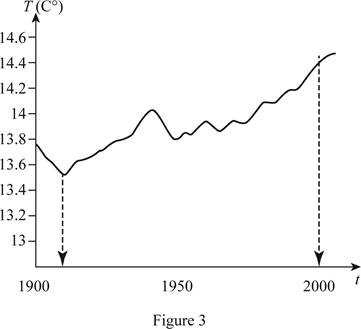
Concept explainers
(a)
To estimate: The global average temperature in the year 1950.
(a)
Answer to Problem 9E
The global average temperature in 1950 is 13.8°C.
Explanation of Solution
During the 20th century, the global average temperature in the graph, the x-axis represents the period (t) between 1900 and 2000, and the y-axis represents the global average temperature (T) in degree Celsius.
Draw the vertical line from the year 1950 to meet the graph of global average temperature during the 20th century. And then, draw the horizontal line towards the y-axis as shown below in Figure 1.

From Figure 1, it is found that the temperature in 1950 is below 14°C and approximate to 13.8°C. Therefore, the temperature was about13.8°C.
(b)
To estimate: The year when the average temperature was 14.2°C.
(b)
Answer to Problem 9E
The average temperature was nearly 14.2°C in the year 1990.
Explanation of Solution
Draw the horizontal line from 14.2°C to meet the graph of global average temperature during the 20th century. And then, draw the vertical line until it meets the x-axis, which is shown below in Figure 2.

From Figure 2, it is found that the average temperature was 14.2°C in the year 1990.
(c)
To estimate: The year in which the temperature was too high and too low.
(c)
Answer to Problem 9E
The temperature was too low in the year 1910 and it was too high in the year 2005.
Explanation of Solution
The graph of the global average temperature during the 20th century follows the cyclic pattern with highs and lows. Draw the vertical lines from the lowest temperature to the highest temperature towards x-axis as shown below in Figure 3.

From Figure 3, it is noticeable that the temperature was the lowest around
From Figure 3, it is noticeable that the temperature was the mostly around
(d)
To estimate: The range of T.
(d)
Answer to Problem 9E
The range of T is
Explanation of Solution
The range of a function is the set of all possible y values of the graph. Thus, the range of the function is
Chapter 1 Solutions
Single Variable Calculus: Concepts and Contexts, Enhanced Edition
 Calculus: Early TranscendentalsCalculusISBN:9781285741550Author:James StewartPublisher:Cengage Learning
Calculus: Early TranscendentalsCalculusISBN:9781285741550Author:James StewartPublisher:Cengage Learning Thomas' Calculus (14th Edition)CalculusISBN:9780134438986Author:Joel R. Hass, Christopher E. Heil, Maurice D. WeirPublisher:PEARSON
Thomas' Calculus (14th Edition)CalculusISBN:9780134438986Author:Joel R. Hass, Christopher E. Heil, Maurice D. WeirPublisher:PEARSON Calculus: Early Transcendentals (3rd Edition)CalculusISBN:9780134763644Author:William L. Briggs, Lyle Cochran, Bernard Gillett, Eric SchulzPublisher:PEARSON
Calculus: Early Transcendentals (3rd Edition)CalculusISBN:9780134763644Author:William L. Briggs, Lyle Cochran, Bernard Gillett, Eric SchulzPublisher:PEARSON Calculus: Early TranscendentalsCalculusISBN:9781319050740Author:Jon Rogawski, Colin Adams, Robert FranzosaPublisher:W. H. Freeman
Calculus: Early TranscendentalsCalculusISBN:9781319050740Author:Jon Rogawski, Colin Adams, Robert FranzosaPublisher:W. H. Freeman
 Calculus: Early Transcendental FunctionsCalculusISBN:9781337552516Author:Ron Larson, Bruce H. EdwardsPublisher:Cengage Learning
Calculus: Early Transcendental FunctionsCalculusISBN:9781337552516Author:Ron Larson, Bruce H. EdwardsPublisher:Cengage Learning





